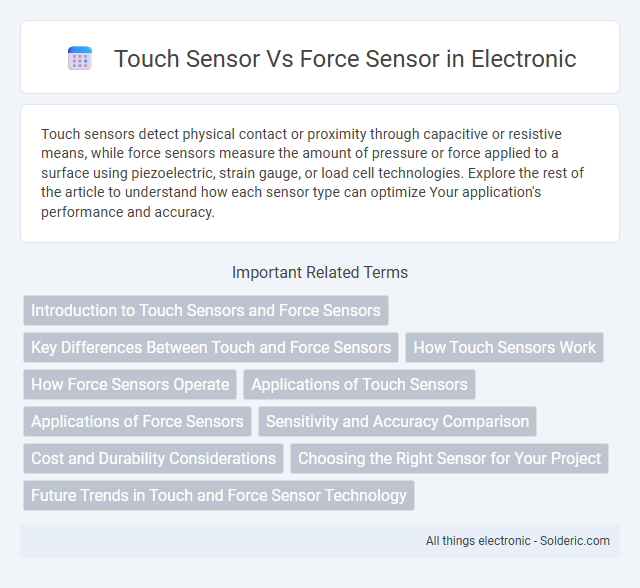Touch sensors detect physical contact or proximity through capacitive or resistive means, while force sensors measure the amount of pressure or force applied to a surface using piezoelectric, strain gauge, or load cell technologies. Explore the rest of the article to understand how each sensor type can optimize Your application's performance and accuracy.
Comparison Table
| Feature | Touch Sensor | Force Sensor |
|---|---|---|
| Definition | Detects presence or absence of touch or contact | Measures the amount of applied force or pressure |
| Primary Use | Touchscreens, buttons, gesture control | Force measurement in robotics, medical devices, industrial controls |
| Output Type | Binary or capacitive signal indicating touch | Analog or digital signal proportional to force |
| Technology | Capacitive, resistive, optical | Piezoelectric, strain gauge, capacitive force sensing |
| Sensitivity | Detects contact presence, less precise force details | Quantifies exact force magnitude applied |
| Applications | Smartphones, tablets, touchpads | Robotics, prosthetics, pressure mapping |
| Cost | Generally lower | Usually higher due to complexity |
Introduction to Touch Sensors and Force Sensors
Touch sensors detect physical contact by measuring changes in capacitance, resistance, or pressure on a surface, enabling devices to respond to user input through touch. Force sensors measure the amount of force or pressure applied to an object, often using strain gauges or piezoelectric materials, allowing precise quantification of mechanical load. Understanding the differences between your touch sensor and force sensor options is crucial for selecting the right technology for applications requiring either simple contact detection or accurate force measurement.
Key Differences Between Touch and Force Sensors
Touch sensors detect the presence or absence of physical contact by sensing changes in electrical properties, while force sensors measure the magnitude of applied force or pressure. Touch sensors are commonly used in capacitive or resistive touchscreen devices to capture simple tap or swipe actions, whereas force sensors provide precise quantification of pressure for applications like robotics or medical devices. Understanding these key differences helps you select the appropriate sensor based on whether detecting touch or measuring force is critical to your project.
How Touch Sensors Work
Touch sensors detect physical contact through capacitive or resistive technology, measuring changes in electrical properties when a finger or conductive object touches the surface. Capacitive touch sensors identify changes in capacitance caused by the conductive properties of the human skin, while resistive sensors register pressure by detecting changes in electrical resistance between layers. These mechanisms enable precise input detection in devices such as smartphones, tablets, and interactive displays.
How Force Sensors Operate
Force sensors operate by detecting the amount of physical pressure or force applied to them, often using resistive, capacitive, or piezoelectric elements that change electrical properties in response to mechanical stress. Unlike touch sensors that simply register the presence or absence of contact, force sensors quantify the intensity of the applied force, providing precise measurement data. These sensors are widely used in applications requiring force feedback or measurement, such as robotics, industrial automation, and medical devices.
Applications of Touch Sensors
Touch sensors are widely used in consumer electronics, such as smartphones, tablets, and touch-screen laptops, enabling intuitive user interfaces and gesture controls. They are integral to interactive kiosks, smart home devices, and automotive control panels, providing precise input detection for enhanced user experience. In robotics and healthcare, touch sensors facilitate safe human-machine interaction by detecting contact and pressure changes.
Applications of Force Sensors
Force sensors are widely used in robotics for precise grip control and load measurement, ensuring delicate object handling and safety. In automotive industries, they monitor torque and pressure to enhance vehicle performance and safety systems. Industrial automation relies on force sensors for assembly line quality control, detecting variations in applied force to maintain product consistency.
Sensitivity and Accuracy Comparison
Touch sensors detect surface contact through changes in capacitance or resistance, offering high sensitivity to light touches but limited accuracy in measuring pressure levels. Force sensors measure applied force or weight with greater precision, enabling accurate quantification of varying pressure intensities, often using piezoelectric or strain gauge technologies. Sensitivity excels in touch sensors for detecting presence, while force sensors provide superior accuracy for pressure measurement and force quantification.
Cost and Durability Considerations
Touch sensors generally offer lower costs due to simpler technology and mass production, making them ideal for budget-sensitive applications. Force sensors, incorporating more complex materials and components, tend to be more expensive but provide greater durability under high-stress conditions. Your choice between touch and force sensors should balance upfront cost constraints with long-term reliability requirements based on usage scenarios.
Choosing the Right Sensor for Your Project
Selecting between a touch sensor and a force sensor depends on the application's sensitivity and input type requirements. Touch sensors detect the presence or absence of contact, ideal for simple on/off control or user interface buttons, while force sensors measure the magnitude of applied pressure, suitable for applications needing precise force detection such as robotics or medical devices. Evaluating factors like response accuracy, durability, and environmental conditions ensures optimal sensor performance for your project's specific needs.
Future Trends in Touch and Force Sensor Technology
Future trends in touch sensor technology emphasize advancements in flexible, transparent materials and integration with AI for enhanced gesture recognition and haptic feedback. Force sensors are evolving toward higher sensitivity, miniaturization, and multifunctionality, enabling precise pressure mapping in medical devices and robotics. Innovations in hybrid sensors combining touch and force capabilities are driving more intuitive and responsive human-machine interfaces.
Touch sensor vs force sensor Infographic

 solderic.com
solderic.com